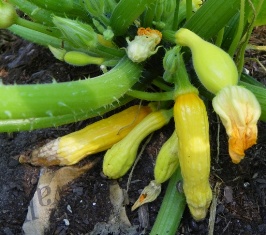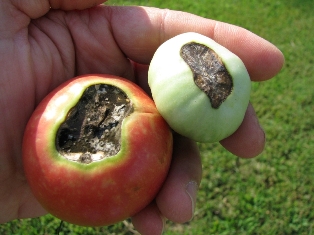Why Are My Squash Rotting?
go.ncsu.edu/readext?221163
en Español / em Português
El inglés es el idioma de control de esta página. En la medida en que haya algún conflicto entre la traducción al inglés y la traducción, el inglés prevalece.
Al hacer clic en el enlace de traducción se activa un servicio de traducción gratuito para convertir la página al español. Al igual que con cualquier traducción por Internet, la conversión no es sensible al contexto y puede que no traduzca el texto en su significado original. NC State Extension no garantiza la exactitud del texto traducido. Por favor, tenga en cuenta que algunas aplicaciones y/o servicios pueden no funcionar como se espera cuando se traducen.
Português
Inglês é o idioma de controle desta página. Na medida que haja algum conflito entre o texto original em Inglês e a tradução, o Inglês prevalece.
Ao clicar no link de tradução, um serviço gratuito de tradução será ativado para converter a página para o Português. Como em qualquer tradução pela internet, a conversão não é sensivel ao contexto e pode não ocorrer a tradução para o significado orginal. O serviço de Extensão da Carolina do Norte (NC State Extension) não garante a exatidão do texto traduzido. Por favor, observe que algumas funções ou serviços podem não funcionar como esperado após a tradução.
English
English is the controlling language of this page. To the extent there is any conflict between the English text and the translation, English controls.
Clicking on the translation link activates a free translation service to convert the page to Spanish. As with any Internet translation, the conversion is not context-sensitive and may not translate the text to its original meaning. NC State Extension does not guarantee the accuracy of the translated text. Please note that some applications and/or services may not function as expected when translated.
Collapse ▲Are the lower ends of your squash turning brown and failing to develop properly? These are the symptoms of a common disorder known as blossom end rot. Recent low nighttime temperatures most likely triggered the blossom end rot we are seeing now. Fruits that show blossom end rot will not develop properly and should be removed from the plant. Several other common soil and weather conditions can cause this disorder, all of which must be managed to prevent blossom end rot from developing at anytime during the harvest season.
GETTING TO THE ROOT OF THE PROBLEM
Blossom end rot most commonly affects tomatoes and squash but can also occur on peppers and watermelons. This problem is not a disease and does not spread from one plant to another. Instead, it is classified as a physiological disorder and is caused by a lack of calcium in the developing fruit. Anytime the absorption or movement of calcium into the plant is slowed, blossom end rot will likely develop. Blossom end rot can be a sporadic or persistent problem, depending on what is preventing calcium from reaching the developing fruits.
While plants absorb calcium from the soil, low soil calcium levels are rarely a cause of blossom end rot in our area. Instead, blossom end rot is most often caused by low soil pH or plant stress due to unusually cool or hot weather, drought, or wet soil conditions. In acidic soils, where the pH is below 5.5, some nutrients are locked up chemically so plants cannot absorb them even if they are present in plentiful amounts. Calcium is one of the nutrients that become less available to plants under acidic conditions. Where low soil pH is the cause of blossom end rot, the problem is usually persistent throughout the entire growing season.
To find out if your soil is acidic or low in calcium, get a soil sample box and paperwork for free from your local Cooperative Extension office and then mail it in. It is $4 per sample December-March. You can look up your report online after a few weeks or less. The pH of acidic soils can be raised by adding lime, but this should only be done if soil test results indicate it is needed. Many soils in our area are high in pH and adding more lime to these soils can increase nutrient deficiency problems. If your pH is low, sprinkling lime on plants or on top of the soil will not help this season, since lime must be mixed into the soil to raise pH. To change pH, lime should be tilled into the soil 6” to 8” deep at least three months before planting. The same is true for gypsum, sometimes referred to as land plaster, a substance that supplies calcium without raising soil pH.
MANAGING NUTRIENTS AND WATER
Over applying fertilizers that are high in nitrogen is another common cause of blossom end rot. Nitrogen promotes rapid, dark green, leafy growth. Plants that are growing very quickly often cannot move enough calcium into fruits to support proper development, leading to blossom end rot. To avoid blossom end rot, be careful not to overdo it with high nitrogen fertilizers like MiracleGro or soda. For season long feeding, rely on slow release fertilizers such as Osmocote or organic fertilizers such as Plant-tone.
In addition to over fertilizing, any conditions that cause root damage can lead to poor nutrient absorption and blossom end rot. The most common causes of root damage in vegetable gardens are wet soils following heavy rainfall or over irrigation. Planting in containers or raised beds will promote good soil drainage and reduce blossom end rot in areas with heavy or clay soils.
Drought is another leading cause of blossom end rot because roots cannot absorb nutrients from dry soils. In fact, the single most important thing you can do to prevent blossom end rot is to keep soils evenly moist by watering during dry weather. Vegetables require between an inch and an inch and a half of water each week from rainfall or irrigation to grow well. When rainfall is lacking, water plants once or twice a week. Soaker hoses are a great way to water vegetables and other plants because they apply water directly to the ground, instead of wetting plant leaves, which can increase disease problems.
LEARN MORE
Learn more about BER and other tomato and squash problems from these Extension resources:
- Preventing BER in Tomatoes (Clemson Extension): http://www.clemson.edu/extension/hgic/hot_topics/2007/07blossomendrot.html
- Tomato Problem Solver (Texas Extension): http://aggie-horticulture.tamu.edu/vegetable/tomato-problem-solver/
- Squash and Cucurbit Problem Solver: http://aggie-horticulture.tamu.edu/vegetable/cucurbit-problem-solver/
- Summer Squash (Clemson Extension): http://www.clemson.edu/extension/hgic/plants/vegetables/crops/hgic1321.html





